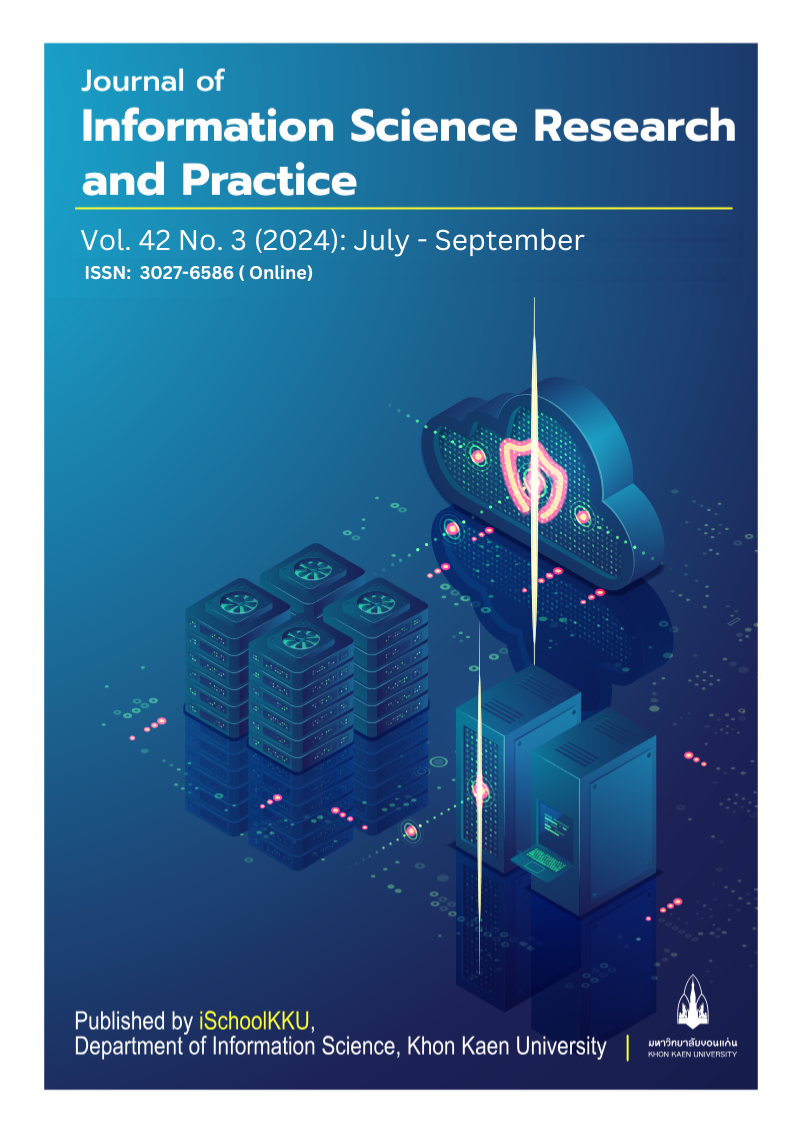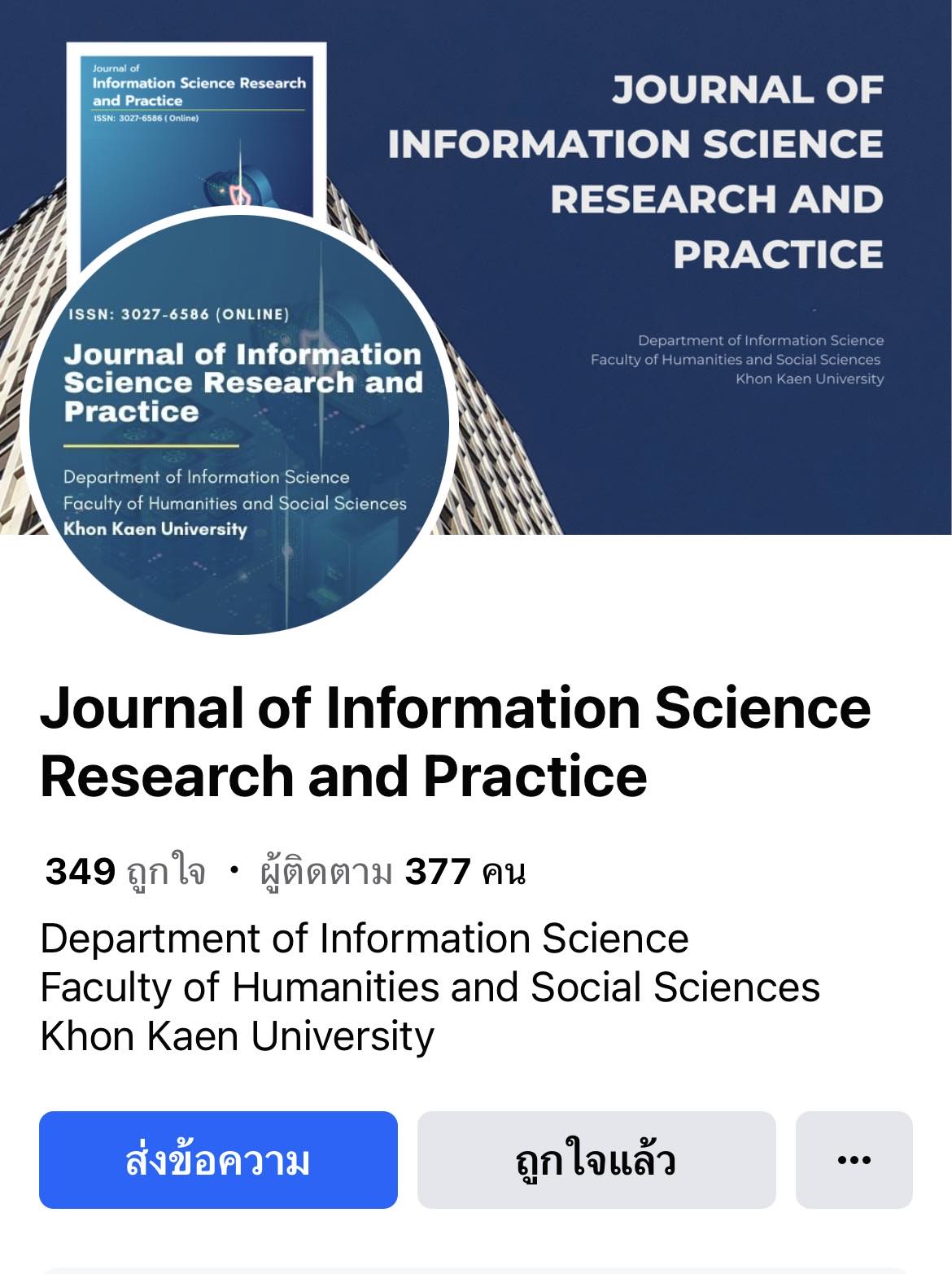The Use of the Bibliometric Method for Analyzing of Knowledge Management and Big Data Research Publications
DOI:
https://doi.org/10.14456/jiskku.2024.23Keywords:
Macro-level Bibliometric Analysis, Micro-level Bibliometric Analysis, Citation Analysis, Co-word analysis, Knowledge Management, Big DataAbstract
Purpose: To study the current state of knowledge management and big data research, and to analyze future research content, directions, and trends.
Methodology: This research employed bibliometric analysis of documents related to knowledge management and big data, published between 2007 and 2023 in the Scopus database. The macro level analysis reflected the general state of research at the national, organizational, publication source, and researcher levels. Meanwhile, the micro-level analysis examined the content and directions of research related to knowledge management and big data.
Findings: The macro-level analysis reveals that research in this field is distributed across all world regions, with China and the United States of America producing the highest publication outputs. Academic institutions produce most of this research output. The micro-level analysis indicates that the future direction of research in knowledge management and big data involves interdisciplinary integration, leading to the development of new tools. Examples include research on artificial intelligence (AI), machine learning, deep learning, and data analytics aimed at extracting knowledge from big data repositories for organizational benefit. Significant research also focuses on technologies supporting semantic analysis, such as the semantic web and ontologies, which help create connections and represent relationships between terms. Furthermore, there is prominent research on the Internet of Things (IoT) for collecting, accessing, and processing big data within cloud computing platforms.
Applications of the Study: The results indicate that bibliometric analysis can be used to analyze and synthesize research both broadly and deeply. Broadly, it demonstrates the advancement of research by identifying the countries and institutions involved and those with expertise in specific research areas. In contrast, the in-depth analysis reveals the core content between the two analyzed disciplines and their connections to other related fields. Additionally, bibliometric analysis is particularly suitable for studying the relationship between knowledge management and big data. The analysis results show a significant correlation, with big data serving as a vast repository of organizational knowledge, while knowledge management is a tool for extracting and utilizing this knowledge. However, due to the diversity and depth of big data, extracting helpful knowledge requires integrating knowledge management processes and tools with various disciplines, such as artificial intelligence, machine learning, deep learning, and ontology. The approach to extracting organizational knowledge depends on the data type and the context in which the knowledge from big data is applied. This perspective highlights the unique outcomes of bibliometric analysis, suggesting that this method could also be applied to analyze research or knowledge in other fields.
Downloads
References
Ackoff, R. (1989). From data to wisdom. Journal of Applied Systems Analysis, 16, 3-9.
Anshari, M., Syafrudin, M., Tan, A., Fitriyani, N. L., & Alas, Y. (2023). Optimisation of Knowledge Management (KM) with Machine Learning (ML) enabled. Information, 14(1), 35. https://doi.org/10.3390/info14010035
Aria, M., & Cuccurullo, C. (2017). bibliometrix: An R-tool for comprehensive science mapping analysis. Journal of Informetrics, 11(4), 959–975. https://doi.org/10.1016/j.joi.2017.08.007
Bag, S., Gupta, S., Kumar, A., & Sivarajah, U. (2021). An integrated artificial intelligence framework for knowledge creation and B2B marketing rational decision making for improving firm performance. Industrial Marketing Management, 92, 178-189. https://doi.org/10.1016/j.indmarman.2020.12.001
de Bem Machado, A., Secinaro, S., Calandra, D., & Lanzalonga, F. (2022). Knowledge management and digital transformation for Industry 4.0: A structured literature review. Knowledge Management Research and Practice, 20(2), 320-338. https://doi.org/10.1080/14778238.2021.2015261
Donthu, N., Kumar, S., Mukherjee, D., Pandey, N., & Lim, W.M. (2021). How to conduct a bibliometric analysis: An overview and guidelines. Journal of Business Research, 133, 285-296. https://doi.org/10.1016/j.jbusres.2021.04.070
Hetter, K. (2023). What does the end of the Covid-19 national emergency mean? Our medical analyst explains. Retrieved from https://edition.cnn.com/2023/05/11/health/coronavirus-booster-vaccine-pandemic-wellness/index.html
Karaboğa, T, Şehitoğlu, Y., & Karaboğa, H.A. (2022). The evolution of big data in knowledge management: A bibliometric analysis. Information World, 23(1), 49-79.
Lim, W.M., & Kumar, S. (2024). Guidelines for interpreting the results of bibliometric analysis: A sensemaking approach. Global Business and Organizational Excellence, 43(2), 17-26. https://doi.org/10.1002/joe.22229
Martín-Martín, A., Thelwall, M., Orduna-Malea, E., & Delgado López-Cózar, E. (2021). Google Scholar, Microsoft Academic, Scopus, Dimensions, Web of Science, and OpenCitations’ COCI: A multidisciplinary comparison of coverage via citations. Scientometrics, 126(1), 871-906. https://doi.org/10.1007/s11192-020-03690-4
Mirhashemi, A., Amirifar, S., Kashani, T.A., & Zou, X. (2022). Macro-level literature analysis on pedestrian safety: Bibliometric overview, conceptual frames, and trends. Accident Analysis and Prevention, 174, 106720. https://doi.org/10.1016/j.aap.2022.106720
Nakagawa, S., Samarasinghe, G., Haddaway, N.R., Westgate, M.J., O'Dea R.E., Noble, D.W.A., & Lagisz, M. (2019). Research weaving: Visualizing the future of research synthesis. Trends in Ecology and Evolution, 34(3), 224-238. https://doi.org/10.1016/j.tree.2018.11.007
Nonaka, I., & Takeuchi, H. (1995). The knowledge creating company: How Japanese companies create the dynamic of innovation. New York: Oxford University.
Rothberg, H.N., & Erickson, G.S. (2017). Big data systems: Knowledge transfer or intelligence insights?. Journal of Knowledge Management, 21(1), 92-112. https://doi.org/10.1108/JKM-07-2015-0300
Schmidmaier, D. (1977). Application of bibliometrics in technical university libraries. 1977 IATUL Proceedings. (129-135). West Lafayette: Purdue University
Siririn, J. (2022). Explore 'The Chinese Graduate Institute,' the 'Brain Repository' prototype in the 5.0 era. (In Thai). Retrieved from https://www.salika.co/2022/06/14/chinese-academy-of-sciences
Sumbal, M. S., Tsui, E., & See-to, E. W. K. (2017). Interrelationship between big data and knowledge management: An exploratory study in the oil and gas sector. Journal of Knowledge Management, 21(1), 180-196. https://doi.org/10.1108/JKM-07-2016-0262
van Leeuwen, T. (2004). Descriptive versus evaluative bibliometrics. In H.F. Moed, W. Glänzel, & U. Schmoch (Eds.), Handbook of quantitative science and technology research (pp.373-388). Dordrecht: Springer. https://doi.org/10.1007/1-4020-2755-9_17
Wang, X., Lu, J., Song, Z., Zhou, Y., Liu, T., & Zhang, D. (2022). From past to future: Bibliometric analysis of global research productivity on nomogram (2000–2021). Frontiers in Public Health, 10, 1-15. https://doi.org/10.3389/fpubh.2022.997713








